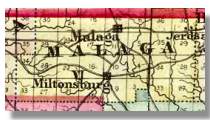Links
Other Counties
 Malaga Township was organized on December 15, 1820, containing
30-3/4 sections. The Western part of Malaga Township is drained by
the various tributaries of Wills Creek and the Eastern part of
Malaga Township is drained by the Baker's Fork and the Grassy
Fork of Sunfish Creek.
Malaga Township was organized on December 15, 1820, containing
30-3/4 sections. The Western part of Malaga Township is drained by
the various tributaries of Wills Creek and the Eastern part of
Malaga Township is drained by the Baker's Fork and the Grassy
Fork of Sunfish Creek.
Malaga Township is located on the high, broad ridge which begins in Summit Township on the South and extends North through Malaga into Belmont County. Professor Andrews said, in 1880, "Traces of thin seams of coal were found from Miltonsburg to Calais. Similar seams were seen about 300 feet below Miltonsburg on the road to the deep valley of Sunfish Creek in Center Township. None of the seams had been opened and are probably too thin, at any rate, to be worked -- except for neighborhood use by the rude method of stripping. They are all high in the geological series but nowhere are they found to be of much practical value. Limestone strata, which aids in fertilizing the soil, were seen."
The first settlements were begun around 1815 by John Hendershot; Stillwell Truex; Matthew Rogers; Martin Fogle; Frederick Hays; William Kennard; Peter Mann; David Lupton; David Mann; and James Graham. It is believed that John Hendershot built the first cabin around 1815 or sooner. The first child in Malaga Township was born to Mr. and Mrs. John Mitchem.
The first election was held at the home of Peter Mann in Malaga in 1820. Twenty-two votes were cast and among the voters were John Hendershot; Peter Mann; William Kennard; Isaac Beardmore; Matthew Rogers; David Lupton; David Mann; Stillwell Truex; James Graham; William Lawrence; Stephen Sloan; Henry Crum; David Sampson; John Strahl; Jonathan Hendershot; Andrew Love; and George Kinney. The first officers of Malaga Township are as follows: Stephen Sloan, Trustee; Henry Crum, Trustee; David Sampson, Trustee; Jonathan Hendershot, Clerk; John Strahl, Treasurer; George Kinney, Constable; and Andrew Love, Justice of the Peace.
It is believed that the first water grist-mill was built by Abner Carleton on Baker's Fork and that the first sawmill was built by Abraham Landis on the same stream around 1817. Mr. Landis lived to be almost 100 years old.
The first school was taught on the farm of David Mann, located on the line between the farms of David Mann and Peter Mann, by David H. Craig in 1818 with 22 scholars in attendance. A school house was built at an early date on the farm of Philip Lawrence near Jerusalem.
Laurenz Schaub and John J. Dorr were among the large German population in Malaga Township. They were among the first to settle around Miltonsburg.
The first meeting house was built in Malaga around 1819. It was free to all denominations. A church was built at an early date East of Malaga and it was known as the Bush Meeting House. The Society of Friends had a meeting house in the same neighborhood at about the same time. The second church which was built was a Baptist church and the third church which was built was a Presbyterian church. A Roman Catholic church was built South of Miltonsburg in either 1835 or 1836. This church was demolished and another Roman Catholic Church, larger than the first, was built on the North side of Miltonsburg. A Methodist Episcopal Church and an Evangelical church was also located in Miltonsburg in 1880
Miltonsburg was organized in 1836 by David Pierson of Woodsfield and it was named after Mr. Pierson's son, Milton.
There was considerable trade in Jerusalem in 1880. East Jerusalem, a short distance from the Village of Jerusalem, was on the Bellaire, Zanesville, and Cincinnati Railroad.
T.S. Fowler and Samuel Groux served as Justices of the Peace for Malaga Township in 1880.